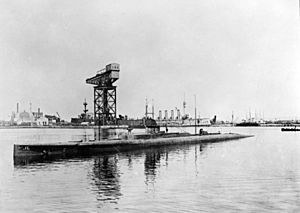Action of 5 November 1916 facts for kids
Quick facts for kids Action of 5 November 1916 |
|||||||
|---|---|---|---|---|---|---|---|
| Part of the First World War | |||||||
 Submarine J1, circa 1919 |
|||||||
|
|||||||
| Belligerents | |||||||
| Commanders and leaders | |||||||
| Strength | |||||||
| 1 submarine | 4 battleships | ||||||
| Casualties and losses | |||||||
| None | Unknown 2 battleships damaged |
||||||
The Action of 5 November 1916 was a small but important naval battle during World War I. It involved a submarine from the Royal Navy (Britain's navy) and a group of powerful battleships (called dreadnoughts) from the Imperial German Navy. This event happened a few months after the big Battle of Jutland. It was important because it showed a big change in how Germany planned to fight at sea.
Contents
Why did this battle happen?
On 2 November 1916, a German U-boat (submarine) named U-30 broke down while on patrol near Norway. It sent out a call for help. Another U-boat, U-20, which was returning from patrol, answered the call. Both U-boats then headed towards the Danish coast to meet a rescue team.
The British navy heard these radio messages. They sent their own destroyers to try and stop the U-boats, but they couldn't find them.
However, on 4 November, both U-boats got stuck in shallow water because of thick fog. German leaders were worried. They feared the Danes might take the U-boats, or that the British would find them. U-20 was especially famous for sinking the passenger ship RMS Lusitania.
To help, Admiral Reinhard Scheer, who led Germany's main fleet (the High Seas Fleet), sent a rescue team. This team included destroyers and a large warship called a battlecruiser, the SMS Moltke. After them came four huge battleships, known as dreadnoughts: SMS König, Grosser Kurfürst, Kronprinz, and Markgraf.
The British also found out about this large German force. They quickly told their submarine, HMS J1, which was already patrolling in that area.
What happened during the battle?
On 5 November, the British submarine J1 was underwater, patrolling in the North Sea. This was about 30 miles (55 km) southwest of Horns Rev. The submarine's captain, Commander Noel Laurence, knew the German ships were coming.
At 11:50 AM, in rough seas, he saw the four German dreadnoughts. They were only about 2 miles (3.7 km) away! Laurence made J1 go deeper to get into a good position to attack. When he came back up to look through his periscope, he saw the dreadnoughts had changed direction and were moving away.
To catch up, Laurence brought J1 to the surface. This was risky because the German destroyers guarding the battleships might spot them. But J1 could move faster on the surface. Laurence managed to get into another good firing spot.
At 12:08 PM, he dived again and launched four torpedoes. Two of them hit! One torpedo struck the battleship Grosser Kurfürst at the back, and another hit Kronprinz at the front. Both battleships were damaged. However, they were still able to sail back to their base.
The German destroyers never saw J1 during its attack. This meant they couldn't fight back effectively. Commander Laurence kept J1 underwater until 2:30 PM. When he surfaced, the sea was empty.
What happened after the battle?
The two damaged German battleships, Grosser Kurfürst and Kronprinz, made it back to port. But they needed repairs for several months. The other German ships returned safely. The U-boat U-30 was also rescued and made it back to base. However, U-20 was too badly stuck to be saved. It was sunk on purpose by its crew to stop the British from capturing it.
Commander Laurence was given another medal, a Bar to his Distinguished Service Order, for his brave actions in this battle.
How did this battle change things?
After this event, Admiral Scheer faced criticism from the German naval chief of staff and even from Kaiser Wilhelm II himself. They felt it was wrong to risk so many important battleships, and have two put out of action, just to save two U-boats.
However, Scheer strongly defended his decision. He argued that it was very important to give full support to the U-boat crews. He also said that Germany's main naval plan should now focus on using U-boats to attack enemy ships. From then on, he believed the main job of Germany's surface fleet (battleships and cruisers) should be to make sure U-boats could safely leave port and return home.
This battle was a clear sign of a big change in German naval policy. Instead of trying to be the strongest navy with its big surface ships, Germany decided to focus on using its U-boats to fight the war by attacking merchant ships.

